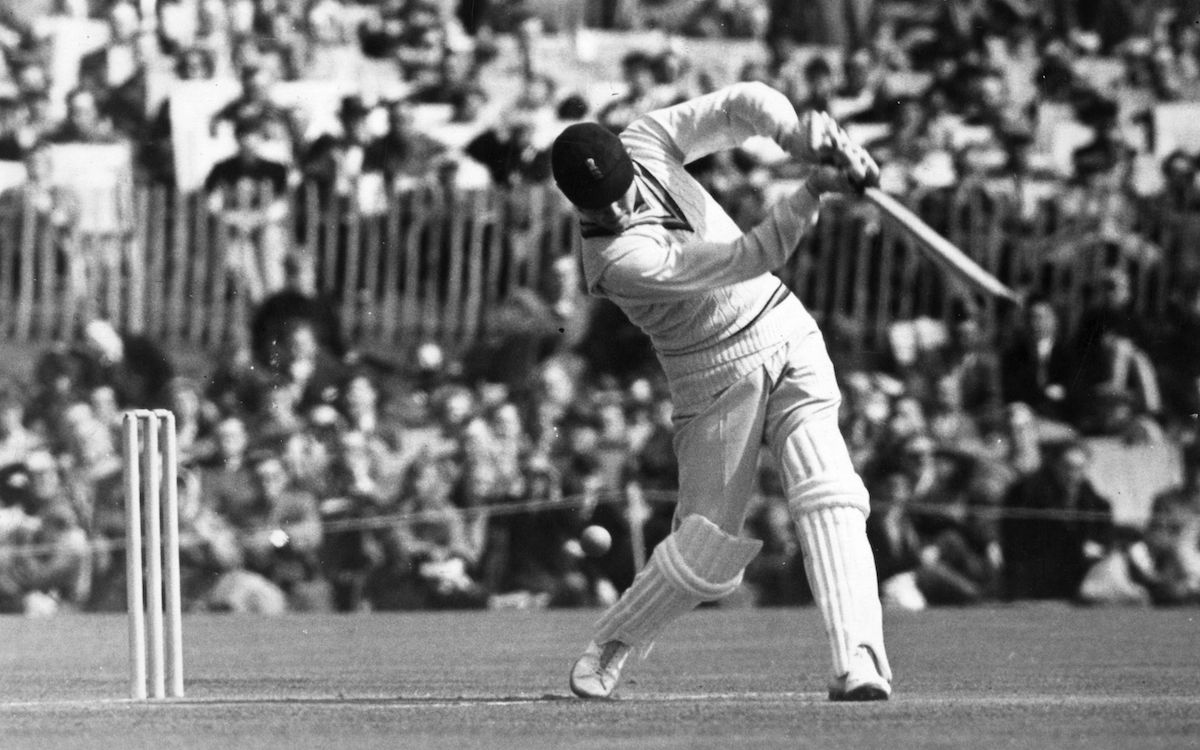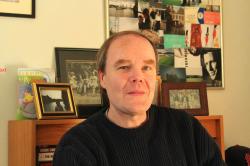You’re facing the Cy Young Award–winning pitcher Justin Verlander from a distance of 22 yards, armed only with a three-foot long, paddle-shaped club and your own nerve. To enliven the proceedings, Verlander interacts with you not from the traditional essentially static crouch, but after a headlong sprint from the outfield to the pitcher’s mound, at the climax of which he hurls a cherry-red leather ball in the general direction of your ankles. In most cases the ball will hit the turf, deviate sharply left or right, and rear up like a skipping rock somewhere toward your unprotected midriff. Other than avoiding serious injury, your job is to score runs—the currency of the game—by striking the ball to the field boundary, or far enough from the 11 fielders to allow you, the batsman, to run to the other end of the infield before the ball can be returned. Due to certain quirks of the game’s rules, the man with the bat can sometimes remain in situ for hours on end, and the contest itself (there are varying formats involved) can last up to five days, with players and spectators going home at around six each evening and returning the following morning.
There, in a nutshell, is cricket, which despite or because of its fabled idiosyncrasies remains the world’s second most popular spectator sport, after only the ubiquitous soccer.
Cricket may appear strange to Americans, but even stranger, perhaps, is the fact of modern American life that the unashamedly Christian athlete who refuses to compromise on—in fact proudly avows—his or her faith can expect a certain amount of disdain at the hands of the mainstream media of a sort it’s somehow hard to imagine being extended to those of other beliefs. To give just a few of the many available examples: the Olympic gold-medal-winning gymnast Simone Biles was ridiculed for being “so, so into Jesus,” as well as for the shocking revelation that she prayed on a daily basis. In a similar vein, the New York Times saw fit to write about the Olympic hurdler and bobsledder Lolo Jones in a piece published just before a major race, mocking her for being “whatever anyone wants her to be—vixen, virgin, victim.”
And then of course there’s the NFL’s Tim Tebow, whose unembarrassed Christianity earned him the cover story in GQ magazine entitled “Have You Accepted Tebow as Your QB and Sunday Savior?” complete with a picture of the Heisman Trophy–winning quarterback altered to make him seem to be in a crucifixion pose. Even that shameless manipulation qualified as mere routine secular bigotry, unexceptional in today’s media, compared to the vitriol of the popular Chicago sportswriter Dan Bernstein, who called Tebow “little more than an affable simpleton” and his admirers “lunatic-fringe cultists” and “batspit crazy fanatics.”
Which all somehow brings us to the life story of the English-born David Sheppard (1929–2005), who enriched the international cricket world of the 1950s and early 1960s.
Sheppard was the only son of a lawyer father and a homemaking mother and related through them respectively to the Victorian illustrator William James Sheppard and the Reverend Thomas “Tubby” Clayton, founder of the Toc H global Christian movement. Broadly speaking, one side of the family had artistic leanings, while the other was noted for its entrepreneurial flair and spiritual piety. The boy David was precociously gifted at sports and remembered both for his striking appearance, with crisp, center-parted dark hair and a smile like that of a young model in a toothpaste advertisement, and academic prowess. Boarding school was followed by two years of mandatory army service and then, belatedly, by Cambridge University.
Sheppard quickly began breaking existing batting records on the college cricket field. In August 1950, the game’s mysterious national selection panel, as arcane in its deliberations as those of a papal conclave, invited him to represent England in an international, or “Test,” match against a visiting team from the West Indies. Readers familiar with baseball’s annual All-Star Game need only think of a 20-year-old rookie being invited to participate and then in short order becoming its star performer to get some of the flavor.
It’s not necessary to dwell at any length on Sheppard’s subsequent career as a professional cricketer. But it touched the very heights of the sport. In 1952 it was the turn of the Indian team to visit Great Britain. At that level, a batsman (one makes another imaginative leap here from baseball) scoring 40 or 50 individual runs is considered eminently respectable, even distinguished. If you’re lucky you might even reach 70 or 80. The still only 22-year-old Sheppard went out to bat for his country against India in a game at The Oval ground in London and scored 119. Making runs in cricket is often less about brute power than it is about delicately placing the ball where no fieldsman is present. One venerable critic exclaimed when watching Sheppard bat: “Poetry!” An England teammate named Godfrey Evans said simply: “I always regarded David as the most graceful player who ever lived.”
In 1953, Sheppard was duly appointed captain of his professional club side, and the following year he achieved the sport’s ultimate accolade by being asked to lead England. It was both a popular and yet not uncontroversial decision by the team’s selectors. The leading alternative candidate, Len Hutton, was widely regarded as a superbly efficient but somewhat dour artisan, while Sheppard’s image was more that of the merry swashbuckler. At that time in English society, there was still a lingering preference for leaders drawn from the ancient universities. It seems almost satirically quaint now, but the received wisdom was that the needs of the England captaincy of the 1950s were better met by a dapper, Cambridge-bred swell than by an honest yeoman.
In any event, Sheppard soon resolved the selectors’ dilemma by announcing his decision to return to his old university to study theology, with a view to taking holy orders. Although he continued to intermittently play cricket until 1963, the sport now took second place to his clerical duties. In September 1955, Sheppard was ordained by the Anglican bishop of London in a ceremony at St. Paul’s Cathedral, and he served his first curacy in Islington, north London, at a time when the area was still a byword for urban decay rather than the spiritual home of Britain’s left-wing intelligentsia. He faced other challenges of a personal nature, too, when his young wife, Grace, collapsed with a serious nervous breakdown. For many years afterward, Grace, with her husband’s help, struggled to fight against agoraphobia.
Sheppard’s first order of business in Islington was to take over a derelict factory building and rename it the Mayflower Family Centre, where among other things volunteers offered addiction and counseling services long before these became fashionable. His passion for social justice spread to his cricketing life. When in 1960 the selectors asked Sheppard to return to play for England against the touring South Africans, he declined the honor in order to protest the system of racial segregation known as apartheid—a scandalous decision to many cricket traditionalists, and one that led to an angry summons by the selectors. On his way to the meeting, Sheppard stopped his car at a traffic light and, as was his habit, picked up the Bible he kept on the passenger seat to read a few verses. The book fell open at Isaiah 58:1: “Cry aloud, spare not, lift up thy voice like a trumpet, and shew my people their transgression.” Thirty minutes later, Sheppard politely informed his hosts in the committee room that he would never again dignify the all-white South African team by playing cricket against them. The affair did a good deal to convince the government in Pretoria of the strength of worldwide anti-apartheid feeling.
Though hardly a single-minded professional sportsman, Sheppard was fully capable of holding his own amid the horseplay and banter, not all of it elevated, of the typical male locker room of the day. He wasn’t just a great cricketer. He was also a character. Among other eccentricities, he sometimes liked to act as his own announcer while on the field. Having swung at and missed a ball, he’d be heard to mutter: “In the match yesterday Sheppard was below form; his footwork was slow, and his strokes were slovenly.” Or, conversely, when smiting the ball out of the park for cricket’s equivalent of a home run (and this necessarily later in the 1950s): “Elvis has left the building.” In addition to his technical brilliance with the bat, he was known for his bravery, keenness, and gentle satirical humor. He once remarked of a particularly flamboyant cricket teammate that “One always expects a chorus of naked ladies to suddenly appear and start dancing around behind him.” He never took offense at the inevitable ribbing about his higher calling in life. Nor did he ever object to a post-match drink with his colleagues. To the best of anyone’s recollection, in the course of a long career he only once protested at an exasperated teammate’s choice of language. “Perhaps best to restrict that particular name to one’s prayer,” Sheppard remarked mildly at the blasphemous outburst. His England colleague Godfrey Evans said of him: “Every teammate liked David, and every opponent respected him.”
Sheppard played his last professional cricket match in March 1963. He became the Anglican bishop of Woolwich in 1969 and bishop of Liverpool six years later. Then aged 45, he was the youngest diocesan bishop in England. He remained an outspoken social campaigner both at home and abroad and continued to vocally oppose the apartheid regime in South Africa. In the early 1980s, he personally lobbied the prime minister, Margaret Thatcher, for increased government funding for a wide range of social programs and would later remember a sticky meeting at No. 10 Downing Street when he was on the receiving end of Thatcher’s tart comments and frequent interruptions. “My mouth went dry as I remembered it doing once or twice when facing a hostile bowler on the cricket field,” he told me. “But I kept going.”
Sheppard’s name was on the short list for the archbishopric of Canterbury when the post fell vacant in 1991. By then Thatcher had been replaced by the cricket fanatic John Major, and several of the British tabloid newspapers got behind “Reverend Dave” for the top job. It wasn’t to be, but in 1997 Sheppard finally retired, he insisted, a happy and fulfilled man.
Perhaps Sheppard could have risen even higher than he did in the Church or in sport. A critic once remarked of him that he had “ambitions rather than ambition.” He was simply too various for the single aim and lacked the ruthlessness of the true careerist. Nonetheless, he played the game he loved to the highest level. He gave and received unbounded affection. And he lived by the belief that only personal friendship, “doing ordinary things together,” rather than lofty abstract principles could truly communicate the gospel. In every sense of the phrase, Sheppard was a robustly muscular Christian who brought distinction on the Church and himself, and in the end you can’t help but wonder if that wasn’t success enough.

